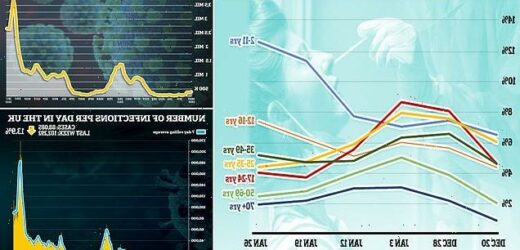Record one in EIGHT children were infected with Covid last week, according to mass testing survey which shows back-to-school effect caused receding outbreak to bounce back
- Office for National Statistics data estimated 13.09 per cent of under-11s in England had Covid last week
- This was above the previous record of 11.8 per cent being infected, set over the previous seven-day spell
- Experts raised concerns the high infection levels will lead to children missing school and passing on the virus
A record one in eight primary school children were infected with Covid in England last week, according to the country’s gold-standard testing survey.
The Office for National Statistics report estimated 13.1 per cent of under-11s had the virus on any given day in the week ending January 26, the latest available. This was above the previous high of 11.8 per cent a fortnight ago.
Primary school pupils are the last remaining unvaccinated age group in the country, and have seen their case rates tick up since schools returned from the Christmas holidays at the start of last month.
Covid cases also hit a record high among secondary school pupils last week with one in 15 (7.6 per cent) infected, while across the country the wave plateaued at 2.6million people currently having the virus.
Experts today raised concerns over the high rates in children, warning that many will miss lessons and risk passing on the virus to others.
More than 50,000 primary and secondary school children were out of classrooms due to Covid in the week to January 20 according to Government figures, the equivalent to one in every 200 pupils.
Despite high infection rates in children, England is moving towards learning to live with the virus in the near future.
Ministers have taken confidence from the growing disconnect between surging cases and hospitalisations and deaths to lift almost all remaining Covid restrictions.
MailOnline analysis yesterday found Covid has a similar fatality rate to flu with 0.2 per cent of cases leading to deaths. For comparison, the rate for flu is around 0.1 per cent.
The above graph shows the proportion of people thought to have the virus by age group in England. It has now reached a record high among under-11s, statistics from the ONS show
And in England estimates suggest that Covid case rates are now beginning to flatline amid surges in some age groups
The ONS’ weekly report — based on random swabs from 100,000 Britons — is considered the gold standard for tracking the UK’s outbreak and is used by ministers to monitor changes in cases.
The random swabbing ensures that the surveillance does not need to rely on people coming forward for tests unlike the official system, allowing it to monitor the prevalence of the virus across the population.
Its publication was pushed to twice a week in December amid the rapid spread of the Omicron variant to allow officials to keep a closer eye on the current wave.
Daily Covid statistics are set to be dropped in April under the Government’s plan to live with the virus like the flu, it was claimed today.
Boris Johnson has already laid out his intention to scrap all remaining Covid laws — including the legal requirement for infected people to self-isolate — by March 24.
And now a senior Whitehall source has claimed daily updates on cases, deaths and hospitalisations will be axed just weeks later.
Experts today hailed the rumoured move, arguing the Government should also push forward plans to end mass testing. Free lateral flows are not expected to be ditched until July.
Professor Paul Hunter, an infectious disease expert at the University of East Anglia, told MailOnline ‘we have to stop producing the daily stats’ at some point.
He claimed April was a ‘reasonable’ time to push ahead with the move, which was leaked to the i newspaper.
The Government source said that the Prime Minister himself has ‘pencilled in Easter as the latest date by which the daily Covid statistics will be published in their current form’.
‘In an ideal situation, he (Mr Johnson) will bring an end to them sooner if the current downward trend in deaths continues,’ the insider added.
‘Ending the daily Covid death toll is part of the Prime Minister’s strategy of living with Covid.
‘It is hoped taking the focus away from the Covid figures will also help people move on with their lives.’
The UK Health Security Agency (UKHSA) and Department of Health and Social Care both declined to comment.
Overall, it estimated 2.63million people in England had Covid last week.
This was marginally up on the 2.62million last week, but the ONS said this change was too small to be
Breaking cases down by age showed they rose among under-16s alongside 17 to 24-year-olds (4.13 per cent infected last week) and 35 to 49-year-olds (5.34 per cent).
But in older age groups who are more vulnerable to the virus and more likely to be boosted infections pointed downwards.
In terms of regions, cases were estimated to be heading up in five — the West Midlands, East of England, London, the South East and the South West.
But in the other areas they were still falling.
Northern Ireland had the highest Covid prevalence (one in 15 people infected) out of the home nations, followed by England and Wales (one in 20), and Scotland (one in 30).
Commenting on the figures, Professor Kevin McConway, a statistician at the Open University, said: ‘Really the best I can say is that most of the changes aren’t large, and that things could be much worse… but many of the trends in numbers… are now either flat or increasing.’
He added: ‘The thing that concerns me most is the continuing increases in infection rates in children of school age and younger.
‘Those infection rates for children remain really very high, and while very few of them will get really seriously ill, there are still consequences in terms of missing school time or infecting others who are more vulnerable.’
Amid reams of promising data showing Omicron was milder than its predecessors, England dumped ‘Plan B’ measures last week.
It meant restrictions requiring face masks in public places, guidance to work from home and vaccine passports were lifted about a month after they were imposed.
Ministers have also unveiled plans to dump the legal requirement to self-isolate if you test positive for the virus by the end of March.
And earlier this week they said the vaccine mandate for NHS staff — requiring them all to be double-jabbed by April — would be dropped.
It was claimed today that daily Covid statistics could also be dropped in April under the Government’s plan to start living with the virus.
A Government source said that the Prime Minister himself has ‘pencilled in Easter as the latest date by which the daily Covid statistics will be published in their current form’.
‘In an ideal situation, he (Mr Johnson) will bring an end to them sooner if the current downward trend in deaths continues,’ the insider added.
‘Ending the daily Covid death toll is part of the Prime Minister’s strategy of living with Covid.
‘It is hoped taking the focus away from the Covid figures will also help people move on with their lives.’
It is expected, however, that an offshoot of Covid called BA.2 could trigger an uptick in cases over the coming weeks.
Analysis from scientists in Denmark — where it is already dominant — suggest it is 33 per cent more transmissible than the old Omicron.
Their study based on 18,000 people also found the version of Omicron is better at infecting vaccinated and booster-dosed people than its parent strain (BA.1).
But, crucially, there was no extra risk of being hospitalised compared to the original Omicron, which was already intrinsically weaker than past variants.
BA.2 cases are surging rising in Britain data shows, with the tally more than quadrupling to 1,197 cases last week. But this is likely only the tip of the outbreak because Britain is now checking just 10 per cent of its cases for mutant strains.
It comes as new Covid cases in the UK fell today after a brief blip earlier in the week as it emerged ministers are looking to scrap the daily virus statistics in April.
There were 88,085 more positive coronavirus tests recorded across the country in the last 24 hours, Government dashboard data shows, down nearly 14 per cent in a week.
A technical error means Scotland’s cases have not been counted but even with their inclusion today’s UK total would likely be down on last Wednesday. Scotland has been reporting 2,800 cases on average this week.
There were also 534 Covid deaths reported today — technically a 54 per cent increase in a week.
However, looking at fatalities by date of death – rather than date reported — shows that the number of people actually dying each day has been falling for over a week.
Source: Read Full Article






